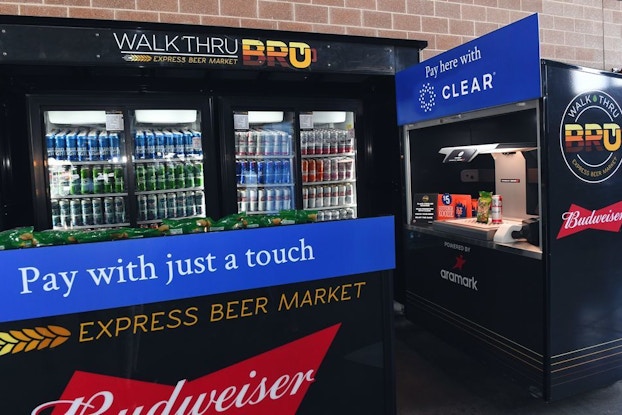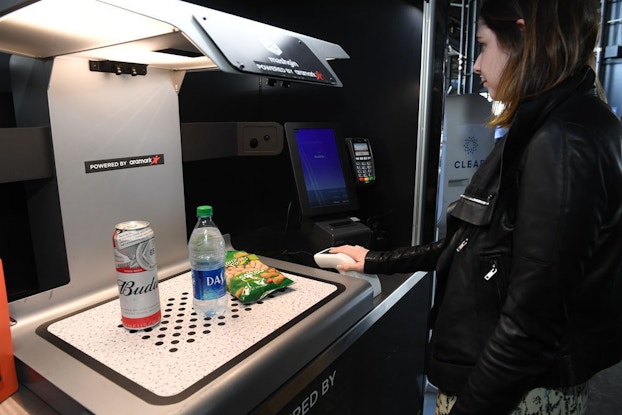
The quality and sophistication of in-home media has made it increasingly attractive for fans to watch sports events from the comfort of their living room couches, but stadiums are fighting back.
As stadiums seek to entice fans out of their homes and into the stands, many are investing in technologies that streamline and enhance the experience. That includes biometrics such as digital fingerprints that make it easier to get into the stadium and purchase concessions, but also tools such as wayfinding that help event attendees navigate the venues, parking lots and transportation options.
Indeed, fans have come to expect that their smartphones can unlock a variety of services that make their everyday lives easier — from location-based maps to digital payments and ride-share services — and they will increasingly expect stadiums to provide a similar level of digital connectivity, said Todd Beilis, partner at Deloitte Media and Entertainment, who leads the stadium experience team at Deloitte.
He cited as an example the Starbucks app, which allows consumers to order a beverage before they get to the store so that it’s ready for them to grab it and go when they arrive. That type of service in a stadium might allow customers to place an order from their seats and pick it up without waiting in line and potentially miss the action, he explained. Some stadiums have already deployed in-seat ordering in certain sections as a luxury perk.
Similarly, high-end suite owners could theoretically be recognized with geolocation devices as soon as they arrive at the venue, triggering the preparation of food in their luxury boxes, for example.
“The goal is to provide one seamless experience to consumers,” Beilis said.
Redefining fans’ in-person experience has become table stakes for sports venues, which are increasingly competing with consumers’ high-tech, home-viewing nests, livestreaming apps and real-time, fan-to-fan engagement online.
“The truth is, it’s very easy to stay at home and watch a game on a 70-inch HD TV and interact with teams via social media,” said Ed O’Brien, head of sports at Clear, which deploys its biometric technology at 24 sports venues around the country. It’s aimed at bridging the convenience gap between home viewing and the stadium experience.
Clear allows fans to use their fingerprints instead of paper or digital tickets to enter sports stadiums and also to purchase concessions, including alcohol, without having to show identification or even open their wallets at some of the venues where it operates.
Citi Field, home of the New York Mets professional baseball team, is tweaking its in-stadium experience to meet the needs of on-demand economy, testing Clear’s technology at the venue in September. The test involved a self-checkout kiosk from technology provider Mashgin where fans could self-scan items, including alcoholic beverages, and check out using Clear’s fingerprint technology.
“We’re continually researching innovative ways to utilize digital technology to create a more streamlined, convenient and frictionless process that allows fans to purchase food faster and get back to their seats,” said Carl Mittleman, president of Aramark’s Sports & Entertainment Division, after the concession operator unveiled a test of the Clear technology at Citi Field.
U.S. Bank Stadium, home of the Minnesota Vikings professional football team, has an app that provides traffic conditions and parking alerts to direct fans to the least congested stadium entrances, for example, according to a recent Deloitte report on stadium technology. It also provides information about the crowd levels at the stadium rest rooms and concession stands and gives fans directions back to their seats.
We’re continually researching innovative ways to utilize digital technology to create a more streamlined, convenient and frictionless process that allows fans to purchase food faster and get back to their seats.Carl Mittleman, president, Aramark’s Sports & Entertainment Division
Ease
Together, Aramark and Clear have unveiled technology in sports stadiums that creates ease and convenience for fans going to games. Read on for more tech trends.

A complex ecosystem: ‘It’s really big and really complicated’
The Deloitte report outlines a three-layer technology strategy in which stadiums will need to build out a base layer of physical infrastructure and software, then a second layer of tools, protocols and data that allow for the top layer of fan experiences. That includes the need for a robust Wi-Fi installation that allows fans to access the various stadium services.
Sports venues are “complex ecosystems” that require a chief technology officer (CTO) who wears many hats, Beilis explained.
“The CTO of a new stadium that's being built, or an existing stadium that's being revitalized, is almost a CTO of a food and beverage company, of a media company, of a retail company, of a network company, a CTO of a mobility company — it’s really big and really complicated,” said Beilis.
While many stadiums have been implementing digital services piecemeal, Beilis believes that eventually all of the various services, from ticketing to concessions to wayfinding, will need to work together to fully streamline the experience for fans.
“We believe that going forward they all need to be integrated,” he said.
In addition, he said, access to fan data will be a critical aspect of the technological enhancements at stadiums. In order to personalize fans’ experiences and leverage potential marketing opportunities, stadium operators and team owners will want to be able to know more about individual fan preferences.
“That means that not only do you need to integrate those experiences, but you need to integrate the data that comes off those experiences in a way that is meaningful,” said Beilis.
He noted that one of the challenges stadium operators will face will be to ensure that they comply with all appropriate privacy regulations as they collect data from their fans.
The use of biometrics — especially face-scanning technology — in public venues has already become a concern among some consumer privacy advocates.
Blink Identity, which offers facial recognition technology for admission to events, came under criticism from privacy groups in the U.K. earlier this year when it was reported that the Manchester City soccer team was planning to introduce the technology at its stadium.
On its website, Blink says it “will never share or sell users’ personal information,” and that the photos it utilizes to create the mathematical representation of users’ facial features in its database are deleted after users submit them.
Clear, which also provides biometric security services at airports and other venues, primarily uses fingerprint technology to verify the identity of its members, but it also has conducted some limited testing using facial recognition.
O’Brien said that company also is not in the data-sharing business.
“We don’t sell or rent any member data,” he said.
CO— aims to bring you inspiration from leading respected experts. However, before making any business decision, you should consult a professional who can advise you based on your individual situation.
Want to read more? Be sure to follow us on LinkedIn!
CO—is committed to helping you start, run and grow your small business. Learn more about the benefits of small business membership in the U.S. Chamber of Commerce, here.

Interested in a small business membership?
Find out how the U.S. Chamber of Commerce can help your company grow and thrive in today's rapidly-evolving business environment. Connect with our team to learn how a small business membership can benefit your bottom line and help you achieve your goals.




